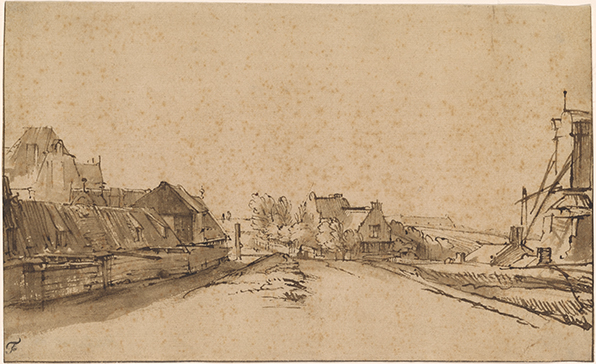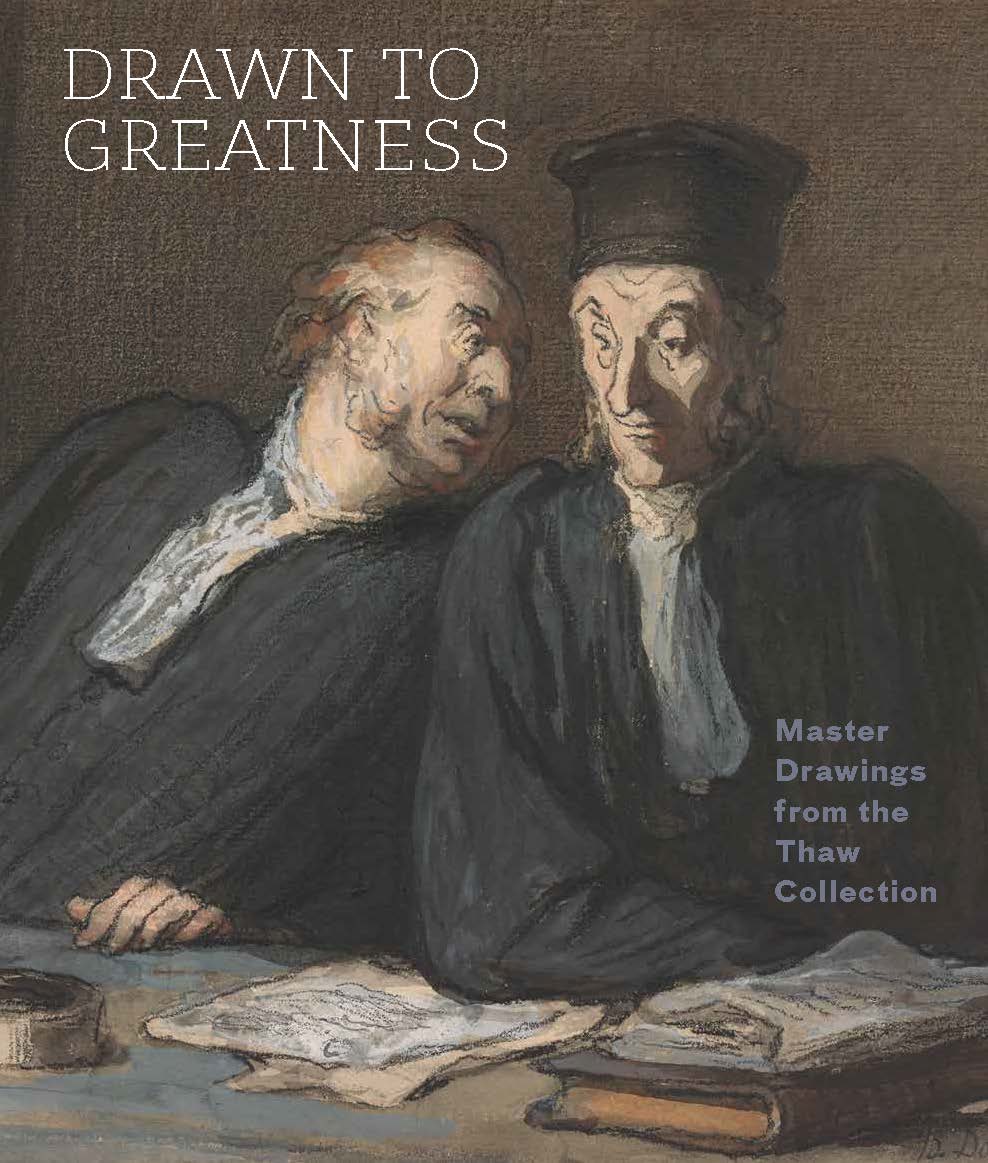
February 3–April 22, 2018
collected in depth
The Thaws collected their favorite artists in depth, including Rembrandt van Rijn, Francisco de Goya, Odilon Redon, and Edgar Degas, among other artists highlighted below.
REMBRANDT VAN RIJN
Dutch, 1606–1669
Rembrandt van Rijn
Dutch, 1606–1669
The Bulwark De Rose and the Windmill De Smeerpot, Amsterdam
c. 1649–52
Pen and brown ink and wash on paper
Morgan Library & Museum, Thaw Collection, 2006.47
Rembrandt van Rijn, a prolific seventeenth-century Dutch painter and etcher whose work encompasses biblical and secular subjects across artistic genres, is renowned for the strength of his drawings, which he often produced in groups. The Thaw Collection includes eleven sheets by Rembrandt. In 2000, when Eugene V. Thaw acquired The Bulwark De Rose and the Windmill De Smeerpot, Amsterdam (c. 1649–52), the pen-and-ink and wash drawing was considered one of the last significant landscape drawings by Rembrandt still in private hands. The drawing, one of a series of twenty-seven landscapes in Rembrandt’s schematic yet carefully detailed style, depicts the environs around an Amsterdam bastion and grain mill with topographical accuracy. Such drawings represent the increasing acceptance and popularity of landscape and scenes from everyday life as independent artistic subjects, especially in Northern Europe.
GIOVANNI DOMENICO TIEPOLO
Italian, 1727–1804
Giovanni Domenico Tiepolo
Italian, 1727–1804
Scene of Contemporary Life: The Quack Dentist
c. 1791
Pen and brown ink and black wash over black chalk
11 5/16 × 16 3/8 in. (28.7 × 41.6 cm); frame: 24 3/4 × 29 1/2 × 1 5/8 in. (62.9 × 74.9 × 4.1 cm)
Morgan Library & Museum, Thaw Collection, 2017.256
Eighteenth-century Italian artist Giovanni Domenico Tiepolo produced lively, often comical, narrative drawings observing Venetian life and character types from the commedia dell’arte, a popular form of improvisational theater performed in piazzas and other outdoor public venues. Tiepolo made sheets and series of independent drawings, such as Scenes of Contemporary Life, which a growing number of connoisseurs collected. The Thaw Collection includes eight sheets by Giovanni Domenico and ten figure drawings by his father Giovanni Battista, under whom the younger artist trained. The selection of eight Tiepolo family drawings included in Drawn to Greatness represents a period of landmark appreciation and commercial success of drawing across Europe.
FRANCISCO DE GOYA
Spanish, 1746–1828
Francisco de Goya
Spanish, 1746–1828
Madness, from the Witches and Old Women Album
c. 1819–23
Gray wash on paper
8 7/8 × 5 1/2 in. (22.5 × 14 cm); frame: 18 3/4 × 15 × 1 1/2 in. (47.6 × 38.1 × 3.8 cm)
Morgan Library & Museum, Thaw Collection, 2017.105
Later in his life, Spanish artist Francisco de Goya often made drawings purely for his own pleasure, filling eight private sketchbooks with incisive and amusing vignettes in ink and wash. Ranging from poking fun at personal idiosyncrasies to scenes from the artist’s imagination, these drawings concentrate on expressions and gestures and provide minimal background detail, though Goya inscribed the drawings with poetic and often enigmatic titles. After the artist’s death, his son Javier divided the albums for sale; their contents survive in museum and private collections as individual sheets. Drawn to Greatness presents four of the eight sheets from the Thaw Collection, works from three separate sketchbooks, including the highly satirical Black Border Album (1816-20) that Goya produced during a period of significant social and political upheaval.
HONORÉ DAUMIER
French, 1808–1879
Honoré Daumier
French, 1808–1879
The Schoolmaster and the Drowning Child
c. 1856–67
Pen and black ink and gray wash, gouache, and black chalk on paper
11 15/16 × 9 5/16 in. (30.3 × 23.7 cm); frame: 22 3/8 × 20 1/4 × 2 1/2 in. (56.8 × 51.4 × 6.4 cm)
Morgan Library & Museum, Thaw Collection, 2010.119
In the 1830s, French artist Honoré Daumier began his career as an illustrator, producing thousands of drawings for Le Charivari and La Caricature, Parisian journals that the French government later shut down for antimonarchist content. After being fined and imprisoned for his scathing satirical images, Daumier turned his focus to less inflammatory subjects, such as scenes from daily life and the foibles of the upper class and members of the judicial system. Inspired by the courts in his neighborhood, Daumier made numerous caricature drawings of lawyers at work. This subgenre of professional types by Daumier is represented by Two Lawyers Conversing (c. 1862) in Drawn to Greatness, which includes three of the five humorous Daumier drawings in the Thaw Collection.
EDGAR DEGAS
French, 1834–1917
Edgar Degas
French, 1834–1917
Three Studies of a Dancer
c. 1880
Black, pink, and white pastel on light brown paper
18 3/4 × 24 3/4 in. (47.6 × 62.9 cm); frame: 29 7/8 × 35 1/2 × 1 7/8 in. (75.9 × 90.2 × 4.8 cm)
Morgan Library & Museum, Thaw Collection, 2001.12
French Impressionist Edgar Degas became renowned for his images of modern Paris and popular entertainments, such as café-concerts, ballet, and horseracing—a body of work represented in the Thaw Collection by twelve sheets and a sketchbook (containing twenty-one drawings). Degas experimented with diverse media, combining conventional drawing techniques with unorthodox materials, such as applying thinned oil paint to paper and using color pastel over prints. During the 1880s, he increasingly explored the possibilities of color pastel, employing the media to create large-scale finished drawings. Academic training, however, instilled in Degas the traditional practice of executing numerous studies of the live model from several angles. Degas’s training is especially evident in Three Studies of a Dancer (c. 1880), one sheet of more than two dozen known sketches he made of Paris Opéra ballet student Marie Geneviève van Goethem, the model for his famous wax sculpture Little Dancer, Aged Fourteen (1881).
PAUL CÉZANNE
French, 1839–1906
Paul Cézanne
French, 1839–1906
Terrace of the Garden at Les Lauves
1902–6
Watercolor over graphite on paper
17 × 21 1/16 in. (43.2 × 53.5 cm); frame: 25 5/8 × 29 3/4 × 1 5/8 in. (65.1 × 75.6 × 4.1 cm)
Morgan Library & Museum, Thaw Collection, 2010.125
In the early years of Impressionism, French artist Paul Cézanne explored naturalistic depictions of light and color; however, he grew increasingly interested in the underlying structure of objects and soon turned toward abstraction. Drawn to Greatness presents six of the Thaw Collection’s eight drawings by Cézanne as well as one sketchbook (containing seventy-five drawings) representing the artist’s prolific late career—specifically watercolors executed between 1900 and 1906 at his studio near Aix-en-Provence, France. Cézanne used watercolor to investigate formal concerns, layering parallel patches of translucent paint in contrasting warm and cold tones to capture subjects ranging from the countryside around the towering Mont Sainte-Victoire to humble tabletop still lifes. Foundational marks of graphite are visible underneath the color washes, whereas the bright paper surface provides highlights. Cézanne also employed untouched areas of paper to lend structure to his compositions. Such drawings, with their expressive distortions and hints of planar elements, appealed greatly to young artists of the early twentieth century, leading to Cézanne’s positioning as a precursor of modern art movements such as Cubism.
JACKSON POLLOCK
American, 1912–1956
Jackson Pollock
American, 1912–1956
Untitled (Abstract Ram)
c. 1944
Opaque paint, pen and black and red ink on paper
Morgan Library & Museum, Thaw Collection, 2010.143
© 2017 The Pollock-Krasner Foundation / Artists Rights Society (ARS), New York
In the early 1940s, American artist Jackson Pollock incorporated diverse sources into his work, including Mexican mural painting, Surrealism, Jungian theories of the unconscious, indigenous art of the American Southwest, and the work of Picasso. The Thaw Collection sheet Untitled (Abstract Ram) (c. 1944), a biomorphic drawing featuring a goat-like figure surrounded by other idiosyncratic imagery, exemplifies his experiments in the medium around the time he began to develop his linear drip and pour paintings. Eugene V. Thaw collected two drawings and a sketchbook (containing forty-three leaves) by Pollock, an artist whose legacy he would preserve through scholarship and philanthropy. In collaboration with American art historian Francis V. O’Connor, Thaw compiled the catalogue raisonné of the work of Jackson Pollock, a four-volume edition for which he sought input from his friend Lee Krasner, a leading abstract expressionist painter and the widow of Pollock. Following Krasner’s death in 1984, Thaw established the Pollock-Krasner Foundation, a private organization that exclusively awards grants to working visual artists of merit around the world.
A fully illustrated catalogue, edited by Jennifer Tonkovich, accompanies the exhibition. The publication features a series of essays by leading scholars devoted to pivotal moments in the history of drawing, as well as an essay recounting Eugene V. Thaw’s career as a collector of master drawings and a catalogue raisonné documenting the Thaw collection in full. Hardcover; 295 pages. Call the Museum Store at 413 458 0520 to order



